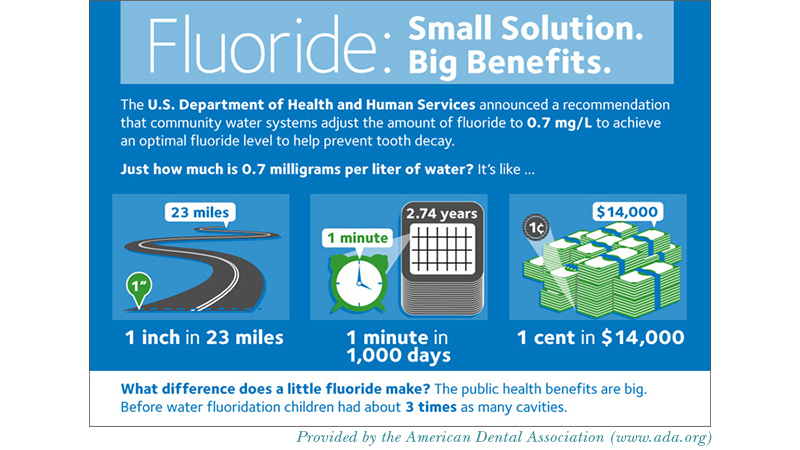

By Deborah Foote
In April, the U.S. Department of Health and Human Services (HHS) announced their final recommendation for the optimal fluoride level in drinking water to prevent tooth decay at 0.7 milligrams per liter. Most U.S. cities and communities are already fluoridating their water at this level, and this new recommendation does not reflect a change in the evidence supporting the safety and effectiveness of this intervention.
Previously, it was understood that more fluoride was needed in some places and less in others, because research had shown people consumed different amounts of water according to where they lived geographically (warm versus cool climates). With the advent of air conditioning, new research shows there is no longer a significant difference in water consumption nationwide.
Additionally, fluoride is now found in a variety of sources, including toothpaste, mouth rinse, professionally applied treatments, water and processed foods. Both factors influenced the new recommendation. The optimal level is set to prevent tooth decay, while minimizing the incidence of dental fluorosis (a mild change in the appearance of the tooth’s enamel). HHS now recommends one level for the entire nation.
This recommendation makes no change to the position of the Campaign for Dental Health, Centers for Disease Control and Prevention (CDC), American Academy of Pediatrics, American Dental Association and hundreds of other organizations that fully support community water fluoridation as a proven public health intervention.
Dental disease is the most common childhood disease and is associated with diabetes, adverse pregnancy outcomes, heart disease and lost school and work hours. Fluoridated water decreases tooth decay by nearly 25 percent in children and adults, and it saves communities money by reducing costs and lost work hours spent on repairing tooth decay. As this CDC literature observes: “For most cities, every $1 invested in community water fluoridation saves $38 in dental treatment costs.”
Decades of studies and the experience of tens of millions of people have affirmed that water fluoridation helps prevent cavities. The HHS announcement is based on solid science. Fluoridation continues to be the cheapest and most effective way to reduce cavities for all Coloradans.